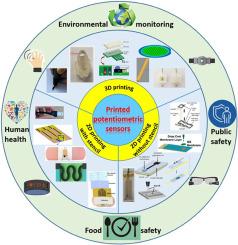印刷电位传感器
IF 12
1区 化学
Q1 CHEMISTRY, ANALYTICAL
引用次数: 0
摘要
从环境监测,工业过程控制,到护理点生物流体分析,离子传感一直是一个关键的话题。作为离子传感最合适的工具,电位离子传感器通常用于这些领域。今天,全球使用电位传感器进行了超过10亿次测量,数百家公司销售带电位传感器的即用型血气分析仪。在过去的几十年里,印刷技术的巨大进步为低成本、大规模和强大的新一代可穿戴设备和电子皮肤的未来电位离子传感器的制造开辟了一个新的范例。遗憾的是,到目前为止,完全印刷的电位离子传感器还没有真正实现。因此,迫切需要解决传感器制造方面的挑战,并进一步扩展电位离子传感器的应用场景。本文重点介绍了通过打印技术(包括2D和3D打印)制造的最新电位传感器。讨论了这些打印传感器的应用场景。并对目前存在的挑战和未来的发展前景进行了展望。我们希望这一综述将有助于对印刷电位传感器的理解,并为这些化学传感器的广泛应用铺平道路。本文章由计算机程序翻译,如有差异,请以英文原文为准。

Printed potentiometric sensors
From environmental monitoring, industrial process control, to point-of-care biofluid analysis, ion sensing has always been a pivotal topic. As the most suitable tool for ion sensing, potentiometric ion sensors are routinely used in these areas. Today, over a billion measurements with potentiometric sensors are preformed globally and hundreds of companies sell ready to use blood-gas analyzers with potentiometric sensors. Tremendous advances over the past decades in the printing technology have opened a new paradigm for low-cost, large-scale and robust fabrication of a new generation of future potentiometric ion sensors for wearable devices and electronic skin. Unfortunately, up to now, the fully printed potentiometric ion sensor has not yet been truly realized. Hence, it is highly desired to address the sensor fabrication challenges, and further extend application scenarios of potentiometric ion sensors. Herein, up-to-date potentiometric sensors fabricated via the printing technology including 2D and 3D printing are highlighted. The application scenarios of these printed sensor are also discussed. Furthermore, the existing challenges and future prospects are provided. We hope that this review will shed new lights on the understanding of printed potentiometric sensors and pave the way for the widespread applications of these chemical sensors.
求助全文
通过发布文献求助,成功后即可免费获取论文全文。
去求助
来源期刊

Trends in Analytical Chemistry
化学-分析化学
CiteScore
20.00
自引率
4.60%
发文量
257
审稿时长
3.4 months
期刊介绍:
TrAC publishes succinct and critical overviews of recent advancements in analytical chemistry, designed to assist analytical chemists and other users of analytical techniques. These reviews offer excellent, up-to-date, and timely coverage of various topics within analytical chemistry. Encompassing areas such as analytical instrumentation, biomedical analysis, biomolecular analysis, biosensors, chemical analysis, chemometrics, clinical chemistry, drug discovery, environmental analysis and monitoring, food analysis, forensic science, laboratory automation, materials science, metabolomics, pesticide-residue analysis, pharmaceutical analysis, proteomics, surface science, and water analysis and monitoring, these critical reviews provide comprehensive insights for practitioners in the field.
 求助内容:
求助内容: 应助结果提醒方式:
应助结果提醒方式:


